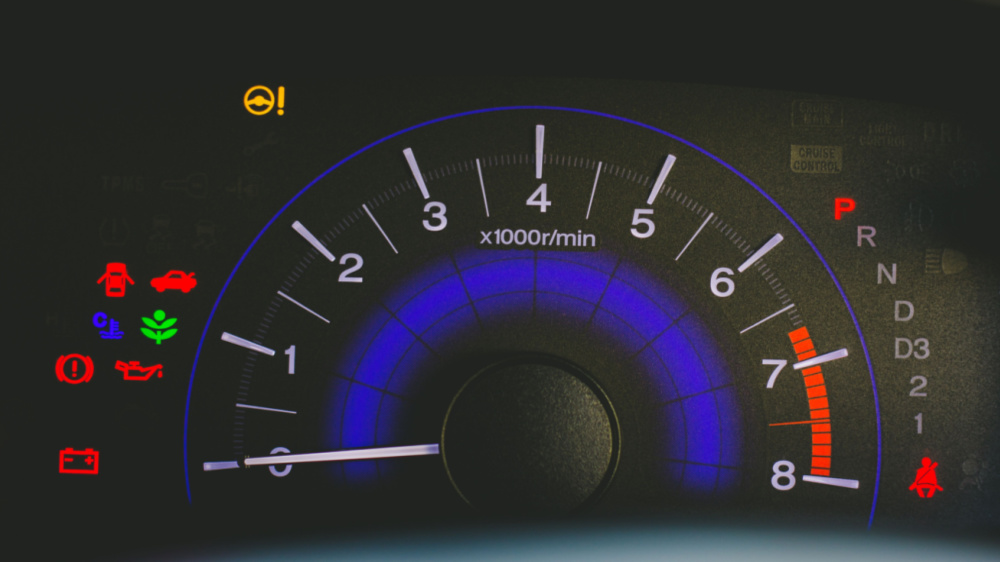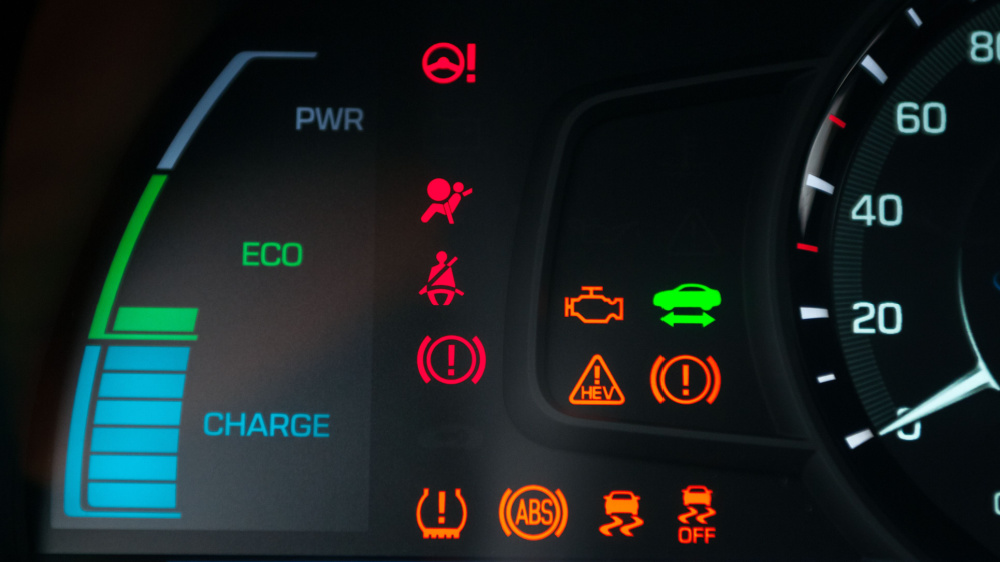
You are driving down the road when all of a sudden you see a symbol on your dashboard light up. If this has ever happened to you, you know the sinking feeling you get when you see dashboard lights that shouldn’t be there. There’s absolutely a solution, but it’s a good idea to pull over before you frantically look through the owner’s manual to try and identify if there’s a problem.
Modern cars have what some would say are too many systems that can all go wrong. Choosing the right car insurance protection is right up there with understanding all the lights and symbols suddenly blinking on your dashboard and when it’s OK to chill out versus take immediate action.
If you are a parent teaching your child to drive, take the time to go over the various lights and symbols so your child understands they need to pay attention when something lights up.
Warning Lights vs Indicator Lights
Your modern car is equipped with warning and indicator lights. These dashboard lights come in the form of symbols, for the most part, some of which you are familiar with and some you may have never seen before. For the most part, indicator lights are normal beacons designed to let you know your modern car’s many systems are on and functioning.
However, warning lights and symbols may be indicative of an issue that needs your immediate attention.
Types of Car Dashboard Symbols
As mentioned, your dashboard has the ability to signal you when things are working as they should and when something is wrong. These indicators are all part of the modern car’s safety features. Keep reading to understand the difference.
Engine Warning Lights
Since the engine is the brain and the brakes are the brawn, both of these systems have their own set of alerts and alarms to let you know when something is wrong. If there’s a problem with the engine, you may not be able to start and drive. So, let’s take a look at some of the engine warning lights.
Check Engine Light
In most cases, there’s no misunderstanding here. This is a picture of an engine, sometimes accompanied by words in all caps that read “Check Engine,” just in case you missed the hint. Drivers tend to get especially anxious when the check engine light comes on and react like their automobile is about to fall apart. And make no mistake: this is a warning light that you should attempt to understand and fix. However, it may be on for as little as a loose gas cap. Or it may be lit up and at the same time, you begin hearing terrible noises from under the hood. If this is the case, stop operating the vehicle and have it towed to a repair shop. Hopefully, it’s nothing more than a loose gas cap.
Service Engine Soon
This runs in tangent with the check engine light, but it may buy you a little time before something really awful happens. You may see the engine symbol, text that says “Service Engine Soon” or both. It typically comes on when the system senses a malfunction. Take your vehicle to the repair shop for a system check.
Engine Temperature
This is a red symbol that looks like a thermometer floating in water and it means your engine is either overheating or on the verge of it. The engine temperature warning light is one you should never ignore. An overheated engine may result in damage that’s too extensive to repair.

Malfunction Indicator Light
Sometimes used interchangeably with the Check Engine Light, the Malfunction Indicator Light (MIL) alerts owners to problems. It may flash occasionally (possible upcoming issues), stays on constantly (could be serious, get it checked) and flashes constantly (engine is misfiring and needs immediate attention).
Reduced Power Warning
This may display as an engine with a downward arrow, indicating decreasing amounts of power. There is a myriad of reasons you may see this symbol on your dash. Since these reasons run the gamut from a system failure to not serious at all, it’s always a good idea to have a professional take a look as soon as possible. The problem could prevent the vehicle from shifting to a stop from acceleration.
Brake System
The brake system in your vehicle is arguably the most important of all since being able to stop your car’s forward progress is vital to your safety. That may be why there are numerous warning and indicator lights for the brakes. Let’s take a look at some of those and whether they are a warning or an indicator.
- A red circle with dashes around the side: This is a warning that the brake pads are becoming worn and should receive attention soon.
- A red circle with an exclamation point in the middle: This is a warning for an issue with the brake fluid in the master cylinder and should be addressed quickly.
- A red circle with a “P” in the middle: This can be an indicator (your parking brake or handbrake is engaged and needs to be released) or there’s something wrong with the parking brake system.
- The yellow letters “ABS”: This is your auto’s anti-lock brakes system. This light will briefly illuminate when you start your car (indicator), but if it remains illuminated, it indicates the system has been deactivated (warning). There are numerous reasons why this may happen, so take it in for an examination.
Because brakes are so important, there are some last-ditch measures you can take if your anti-lock brakes fail, or you have regular brakes. Push your brake pedal to the floor and hold it there. Next, push the brake pedal a few times to try and build up hydraulic pressure.
Other Warning Lights
Your vehicle has many different systems that work together to get you down the road safely. When something goes wrong in that system – or when things are on the verge of malfunctioning – your automobile will kindly let you know. These warnings will typically come in 2 colors, red and yellow/orange.
A red warning light should never be ignored. This means your vehicle has detected a serious problem. Not only can this affect the safety of your ride, but it could also lead to something that may destroy your car – or cost more to fix than the car is worth. Here are some warning lights that you may see illuminated on your dashboard.
Transmission
Your transmission is what enables your car to move. That’s probably why the symbol looks like a wheel with a symmetrically broken up outside and an exclamation point in the middle. Since replacing the transmission is an expensive proposition, if this lights up, you should pay attention. It could mean you have low transmission fluid, or your power steering fluid level is low. Either way, it could affect your ability to steer, so get it checked.
Oil Pressure
If the oil in your engine has dropped to a dangerous level, you may see a symbol of an oilcan in either yellow or red. This is an immediate situation since an engine with no lubrication will quickly destroy the moving parts.
Starter System
A starter system malfunction may appear on your dash in text, and it may be due to a blown fuse or dirty contacts. However, this could also indicate problems with an ignition switch, alternator, starter motor, battery or something wrong in the fuel delivery system. In some cases, the vehicle may simply not start during the ignition process when this symbol lights up, however, in many cases, it’s simple fix.
Charging System
This looks like a yellow lit-up battery with a red background. That’s because your battery powers the electrical system, which is vital to your vehicle starting and operating correctly. This can indicate or warn that the battery may be running low and needs to be replaced or charged.

Indicator Lights
Indicators should be more familiar to you since many of them flash briefly when you start your car or remain illuminated while you use that system, such as your high beams. These tell you that the systems represented are working and in good order. Indicators can also be warnings. If they remain illuminated or change from yellow to red, it’s time to take action. Some indicators are represented in blue or green.
High Beams
This can be green or blue and resembles a headlight with 5 bars to the left that represent light rays. Remember to turn off your high beams when approaching another vehicle or coming up behind one.
Airbag System
This looks like a person sitting in a seat with a seat belt on and a large ball representing the airbag deploying in front of the passenger. If the light remains on, it indicates an issue with the airbag system that needs to be checked.
Turn Signal Indicator
Typically represented by arrows, the turn signal indicator may remain steady instead of blinking if there is a problem with your turn lights – maybe just a burned-out bulb.
Seat Belts
Modern cars come with a seat belt reminder to strap up before engaging in moving. This is a picture of a person sitting in a seat with a belt across their chest and lap. Most modern cars come with a somewhat annoying sound if you don’t buckle up! Plus, wearing your seatbelt is now the law in every state.
Parking Brake
As mentioned above, it’s a circle with a “P” in it and it turns on when the parking brake (or handbrake) is engaged.
Cruise Control Indicator
In most cases, if you see this picture of a speedometer with an arrow pointing to a certain speed, it means your cruise control system is on. In yellow or orange, it means on but not activated and in green, it means the system is in use. If it stays on even when the system is not activated, there may be an issue that needs resolving.
Electronic Stability Control
All modern cars have electronic stability control. It is designed to stop skidding and sliding in less than optimum conditions, such as ice. You may see an exclamation point in a triangle with a circular arrow around it or it may be a graphic of swerving car to indicate the traction control is in use. When there is a problem with the ESC, you could experience trouble with your steering wheel, anti-lock brakes or stability.
Safety Warning Lights
Some of your alerts are specifically focused on today’s safety standards. These features are intended to keep the driver and passengers safe while on the road or even when parked.
Tire Pressure
The tire pressure is vital to the safety of your auto. Too little and your tires could blow, causing a suddenly out-of-control vehicle. Too much and you lose some control over steering. The tire pressure warning light is a horseshoe-shaped symbol with an exclamation point in the middle. Any number of things can affect your tire pressure, from a slow leak caused by a nail to an abrupt drop in temperature. Don’t ignore this alarm and check your tire pressure regularly. The correct PSI (pounds per inch) is located on the inside of your driver’s side door.
Door Ajar
It happens to us all. We just don’t close the door or the back all the way. The sign looks like an aerial view of a vehicle with one or more doors open.
Child Safety Lock Indicator
Different brands have different ways of illustrating this handy feature that stops little ones from opening rear doors. It may be a padlock with a child’s face in the middle.
Maintenance Reminder Lights
Newer models make it much easier to remember your regularly scheduled maintenance. You may see a maintenance required alert, a change oil reminder or a washer fluid reminder. Other areas that may show a symbol under maintenance include coolant levels. Since topping off and changing fluids is an important part of helping your wheels to run smoothly for a long time, it’s important to follow your owner’s manual suggested maintenance intervals.
Driver Assistance Indicator Lights
It seems like every year the new models come out with increased safety measures. That’s a good thing for you and your family. Here are some of the recent features:
Lane Departure Warning Light
This handy helper not only gives you a visual cue if you are about to leave your lane suddenly, but you may also get an auditory clue.
Forward Collision Warning Light
We’ve all been driving along, fiddling with the radio, only to look up and see the rear end of the car in front of us approaching way too quickly. It’s a heart-stopper. This feature lets your ride give you an alert when the car in front of you is coming up too fast, so you can take the proper corrective action (like slowing down and stopping playing with the radio!).
Blind Spot Monitoring Light
Have you ever pulled onto the highway and suddenly there is another driver in the very lane you intended to enter? The nerve! Well, this is really on you – sometimes we just forget to manually turn our heads and look. With this safety feature, your vehicle will alert you before a rude honking sound does.
Adaptive Cruise Control Light
Just like our old friend cruise control, this lets you set the speed you want to drive at. But it goes further. It senses when traffic in front and behind slows down and speeds up, then adjusts your speed accordingly.

Responding to Dashboard Lights
Mainly, don’t panic! If you are unfamiliar with all the symbols and warnings that come with today’s cars, you are not alone. But there are things you can, and should, do when your trusty steel steed is telling you something.
Assess the Severity
A warning or alert is indicative of a problem. Is it a serious problem that calls for immediate action or is it a problem that can wait? As you’ve learning, some warnings call for you to stop before inflicting more damage, while some give you enough time to drive to a garage.
Consulting the Owner’s Manual
Ahhh, the ever-ready owner’s manual with its sections, subsections, pictures, graphs and much more fun and enlightening materials. However, your owner’s manual is your best friend when that suspicious dashboard light glares at you.
Service
Unless you are a mechanic, you need to have a regular appointment with one. Remember, there are numerous fluids and parts that should be visited at scheduled intervals. Taking proper care of your vehicle will not only prevent dashboard light issues but will give you a trust ride through numerous years.
Recalls
Keeping an eye out for recalls is critical. Many times they come from the manufacturer in the mail. If you get one, don’t toss it in the trash no matter how insignificant it seems. Many small issues recognized early by manufacturers forestall major issues down the road. And here’s the thing. If you ignore a minor recall and later you develop a major problem, you may not be able to get that fixed for free.
You can also enter your VIN number here to check for any recalls.
Understanding the Importance of Dashboard Lights
Your modern vehicle is a marvel of technology and innovation designed to keep you safer on the roads. A large part of that is warning signs, colors and sounds. If something is wrong or needs help, your ride will let you know in most cases. But if you don’t pay attention, you may be facing some large repair bills or worse, safety issues, down the road.
Regular maintenance and paying attention are the keys to a long and happy life with your car.
Affordable Car Insurance is Another Key Safety Factor
Don’t forget when you are thinking about car safety to think about low-cost auto coverage. At Freeway Insurance, we can help you find the policy that provides the right amount of protection at a price you can afford. You can get a free auto insurance quote online, give us a call at (800) 777-5620 or stop by one of our convenient locations.


